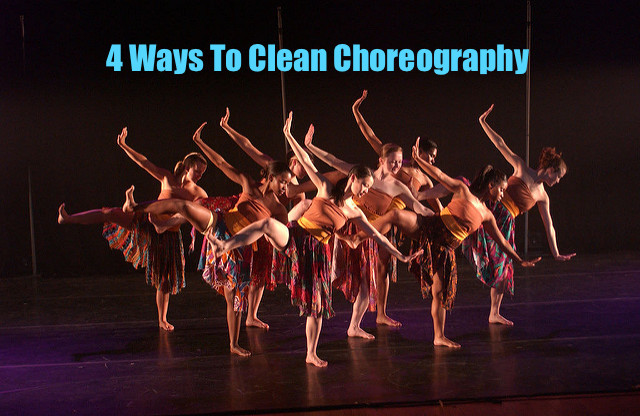Competition and performance season seems to have a way on sneaking up on us all. Inevitably, there is at least one dance that is just not ready to hit the stage. Here are some tools useful in cleaning dances. Try them during your next dance rehearsal.

Know the Counts
In many group pieces, the counts are the glue that holds the piece together. Solidifying the counts in the dancers’ brains should be the first step in cleaning a piece, as it creates a framework for the rest of the cleaning. In order to make sure all dancers are in unison, or on the same count, take the piece one section (say 32 counts) at a time. Have the dancers perform the choreography while counting out-loud, and listen for dancers who are off or unsure.
Break it Down
Performing a choreographed dance requires the coordination of many different elements. To solidify each, run the piece a few times, each time focusing on a different element. For example, do one run with only arms, do a second run with only formations and focus. Breaking the piece down like this will allow you to fine-tune these elements with less distraction.
Take Notes
Always watch a piece with a pencil and paper. Don’t yell notes at your dancers: often, this just causes confusion. Instead, write down corrections. Draw a line in the middle of your page. On the left side, write down individual notes and quick fixes (i.e. an incorrect arm position on a single dancer). On the right side, write more “big picture” issues, such as a messy unison section.
Begin your critique by addressing the notes on the left side. Have dancers show you the corrected movement to ensure they understand. Then, move to the notes on the right side. Start by addressing the most problematic ones. For example, if dancers are lacking focus, go through the dance and explain where focus should be at all times. These notes are necessarily more time consuming. If you do not have time to address these in your dance rehearsal, save your notes for next time. Address them at the beginning of your next rehearsal so that they can be corrected immediately.
Talk it Out
The suggestions above deal with the technical side of a piece, but what about the artistry? I like to have at least one “sit down” conversation with my dancers about each piece. I give them a framework of why I choreographed the piece, what my inspiration was, and what I want them to portray. I then allow them to engage in a discussion with one another about what the piece means to them, and what they feel they portray. This facilitates a more personal connection between the dancers and the piece.
Remember that cleaning dance, like helping young dancers feel confident on stage, takes time and patience. Rather than getting frustrated that a part is “still not clean,” acknowledge the progress that the dancers are making. If there is a rehearsal where you are particularly hard on the dancers, remind them that you are being hard on them because you know how much potential they have to perform the piece well. Always end on a positive note.
Chelsey Bradley is a choreographer, professor, and author. She completed her Master’s Degree in Dance and Choreography in 2017 from the Peck School of the Arts, and then served as a lecturer of dance for the University of Wisconsin, Eau Claire. She currently serves as resident choreographer for Dance Wisconsin, and teaches modern dance for Monona Academy of Dance. Her work for these companies has earned her Regional Dance America’s National Choreographic Commissioning award four times, Regional Dance America’s Choreography Connection Grant in 2014, and a Choreographic Honors Award from the University of Wisconsin, Madison, in 2015. Read Chelsey’s posts.

